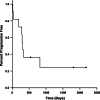Solitary osseous plasmacytomas in dogs: 13 cases (2004-2019)
- PMID: 34467522
- PMCID: PMC9292964
- DOI: 10.1111/jsap.13411
Solitary osseous plasmacytomas in dogs: 13 cases (2004-2019)
Abstract
Objectives: To further characterise solitary osseous plasmacytoma in dogs, an extremely rare disease. To describe diagnosis, disease progression and treatment outcomes in dogs with solitary osseous plasmacytoma.
Materials and methods: Retrospective review of dogs with solitary osseous plasmacytomas that were diagnosed and treated at a single institution from 2005 to 2019. Kaplan-Meier single group survival analysis was used to estimate median survival time and progression-free interval.
Results: Thirteen dogs met the inclusion criteria for the study, and of those, 11 were treated. The median age at diagnosis was 8 years (range 4 to 11). Most solitary osseous plasmacytomas occurred in the vertebrae (n=8). Other sites included the maxilla (n=2), the mandible (n=1), the tibia (n=1) and the carpus (n=1). The median survival time for all dogs with solitary osseous plasmacytoma was 912 days (range 5 to 2179), and the progression-free interval for treated dogs was 310 days (range 22 to 2179). Most dogs were treated with radiation therapy (n=10) with nine of 10 receiving a definitive, daily fractionated protocol and with five of ten having had neoadjuvant surgery. Seven dogs received chemotherapy, which was initiated after progressive disease in five dogs. The median survival time for dogs that completed radiation therapy (n=9) was 1166 days (range 545 to 2179). While five dogs developed lesions at other sites, no dogs progressed to multiple myeloma.
Clinical significance: Canine solitary osseous plasmacytomas can be managed long term with appropriate local therapy. This observation reflects the biologic behaviour observed in humans.
© 2021 The Authors. Journal of Small Animal Practice published by John Wiley & Sons Ltd on behalf of British Small Animal Veterinary Association.
Conflict of interest statement
No conflicts of interest have been declared.
Figures




References
-
- Anil, S. (2007) Solitary plasmacytoma of the maxilla – a case report and review of the literature. General Dentistry 55, 39‐43 - PubMed
-
- Dimopoulos, M. A. & Hamilos, G. (2002) Solitary bone plasmacytoma and extramedullary plasmacytoma. Current Treatment Options in Oncology 3, 255‐259 - PubMed
-
- Elliott, J. , Looper, J. , Keyerleber, M. , et al. (2020) Response and outcome following radiation therapy of macroscopic canine plasma cell tumours. Veterinary and Comparative Oncology 18, 718‐726 - PubMed
-
- Hu, K. & Yahalom, J. (2000) Radiotherapy in the management of plasma cell tumors. Oncology (Williston Park) 14, 101‐108, 111; discussion 111‐102, 115 - PubMed
MeSH terms
LinkOut - more resources
Full Text Sources
Medical
Miscellaneous

